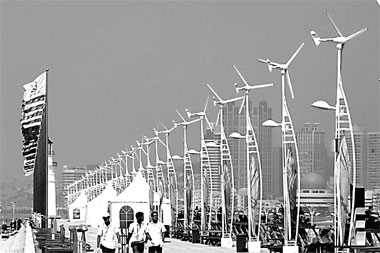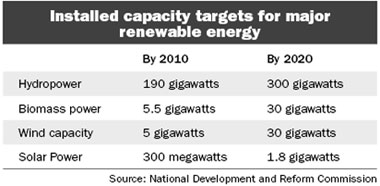


China is figuring out every feasible way to meet bold targets for renewable sources in its energy consumption, a move designed to cut emissions and boost efficiency, the country's top economic planner said last week.
"We have set a challenging but visionary target for renewable energy development over the long and medium-term . We will spare no effort meeting the target by adopting various effective measures," Chen Deming, vice-minister of National Development and Reform Commission (NDRC), China's top industrial watchdog, reveals.
By 2020, NDRC plans to raise the share of renewable energy in China's mixture of total energy consumption to 15 percent compared to the current 8 percent. By 2010, the targeted proportion is 10 percent, Chen reiterated last week.
It is a bold target even judging from a global perspective, Chen admits.
There are mainly two bottlenecks in the wide adoption of renewable energy options - one is the nation's fragmented industrial layout and the other is the lack of advanced technology.
"Especially in the bio-energy sector, projects are scattered in thousands of households," Chen says.
The lack of technology makes it more difficult to lower costs and increase efficiency while developing renewable energy, Chen adds. An example is wind power. China is now capable of building a single wind turbine with a 1.5-megawatt generating capacity, but not more.
Chen notes that through more research and development efforts, China will be able to manufacture wind power generators with 3-megawatt capacity next year. But the country will not stop there. "Our next target is to make 5-megawatt wind turbines," Chen leaks.
According to China's long- and medium-term plan to boost renewable energy, the installed capacity of hydropower is expected to hit 300 gigawatts by 2020. Also by 2020, the installed capacity of biomass power will reach 30 gigawatts, with total installed grid-connected wind capacity to hit 30 gigawatts.

By 2010, the target for developing hydropower is 190 gigawatts, with biomass power targeted at 5.5 gigawatts and wind capacity at 5 gigawatts.
To meet the targets, China will spend around 2 trillion yuan, one-tenth of its 2006 gross domestic product (GDP) to fuel the development of renewable energy.
"Overall, around 2 trillion yuan of investment is demanded to meet the target of renewable energy development by 2020. Necessary investment is key to developing renewable energy," NDRC states in a press release.
The investment budget was calculated based on the combined installed capacity targets of every renewable energy segment, such as hydropower, bio-energy and wind power.
Most of the investment will come from market investment and financing, with a small proportion from the government, Chen implies.
"As long as there are encouraging policies from the State, investment from the market will support the development of renewable energy. The State does not have to pour too much money in," Han Xiaoping, an independent analyst with China5e.com, contends.
The government will work out various measures to guide and encourage the development of renewable energy, Chen says.
"We will come up with various taxation and fiscal incentives, including establishing funds to subsidize the renewable energy industry and granting tax breaks," Chen says.
Preferential taxation and fiscal policies will treat companies of all kinds of ownership as equals, rather than just giving favor to State-owned giants, according to Chen. "A lot of firms within the renewable energy segment are privately owned. They are shouldering great responsibility in driving the segment forward. Our preferential policies will not treat them as second-tier players," Chen adds.
Also NDRC will work harder to improve the market environment and increase the market share of renewable energy.
The country will keep its electricity prices capped for the time being to boost the development of renewable energy. "It costs more to produce power from wind, solar and biomass sources, and people will shift only to the cheaper coal-fired power if we liberalize the electricity tariffs," Chen is quoted saying by Bloomberg.
China will increase hydropower tariffs, Chen says, without giving a timetable. "Tariff will help relieve environmental problems caused by hydropower construction. Pricing incentives will be given to more efficient and cleaner power generation units as part of power-price reforms," he says.
Regarding bio-energy development, the NDRC deputy boss stresses China will stick to the principle of using non-grain sources for biofuel production. NDRC aims to use bio-ethanol and bio-diesel to replace 10 million metric tons of petroleum-based fuels a year by 2020.
China, concerned about the shrinking availability of arable land and rising food prices, is shunning corn-based ethanol projects. Authorities are encouraging ethanol makers to use non-grain sources, such as cassava roots.
The nation currently has four factories producing 1.02 million tons of ethanol from grain, of which 80 percent is from corn.
Despite the fact China has historically generated much less green house gas than its developed counterparts, the country still treats the issue seriously and spares no efforts contributing to carbon dioxide emission reduction by enhancing energy efficiency and developing renewable energy, Chen summarizes.
Setting an ambitious and explicit target for developing renewable energy is a proof of China's commitment to save energy and cut emissions, Chen contends.
(China Daily 09/10/2007 page2)













